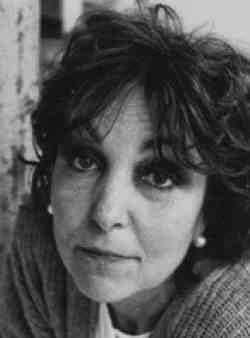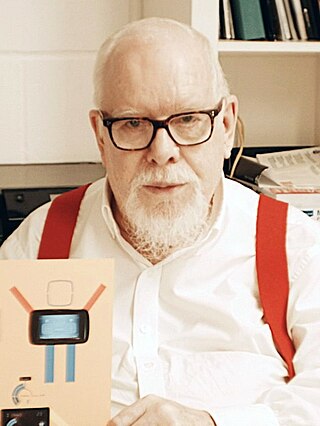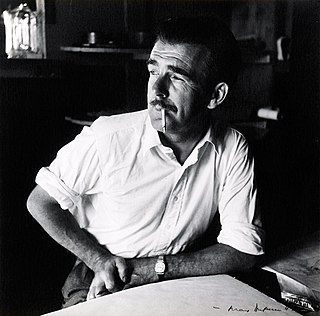Related Research Articles

Frank Helmut Auerbach is a German-British painter. Born in Germany, he has been a naturalised British subject since 1947. He is considered one of the leading names in the School of London, with fellow artists Francis Bacon and Lucian Freud.

Dame Maria Paula Figueiroa Rego was a Portuguese-British visual artist, widely considered the pre-eminent woman artist of the late 20th and early 21st century, known particularly for her paintings and prints based on storybooks. Rego's style evolved from abstract towards representational, and she favoured pastels over oils for much of her career. Her work often reflects feminism, coloured by folk-themes from her native Portugal.

Sir Peter Thomas Blake is an English pop artist. He co-created the sleeve design for the Beatles' 1967 album Sgt. Pepper's Lonely Hearts Club Band. His other works include the covers for two of The Who's albums, the cover of the Band Aid single "Do They Know It's Christmas?", and the Live Aid concert poster. Blake also designed the 2012 Brit Award statuette.

Sir William Dobell was an Australian portrait and landscape artist of the 20th century. Dobell won the Archibald Prize, Australia's premier award for portrait artists on three occasions. The Dobell Prize is named in his honour.
Sir Charles Robert Saumarez Smith is a British cultural historian specialising in the history of art, design and architecture. He was the Secretary and Chief Executive of the Royal Academy of Arts in London from 2007 until he stepped down in 2018. He was replaced by Axel Rϋger, who took up the position in 2019.

Avigdor Arikha was a Romanian-born French–Israeli artist, printmaker and art historian.
John Keith Vaughan, was a British painter. His work is held in the collections of the Government Art Collection, National Galleries Scotland, National Portrait Gallery, Tate and Victoria and Albert Museum in the UK.
Steven Campbell (1953–2007) was a painter from Scotland.
Victor Arthur James Willing was a British painter, noted for his original nude studies. He was a friend and colleague of many notable artists, including Elisabeth Frink, Michael Andrews and Francis Bacon. He was married to Portuguese feminist artist Paula Rego.
Sarah Natasha Raphael was an English artist best known for her portraits and draughtsmanship.
Christopher Bramham is a painter from Britain.
Matthew Xavier Maillard Carr was an artist from Britain.

Marlborough Fine Art was founded in London in 1946 by Frank Lloyd and Harry Fischer. In 1963, a gallery was opened as Marlborough-Gerson in Manhattan, New York, at the Fuller Building on Madison Avenue and 57th Street, which later relocated in 1971 to its present location, 40 West 57th Street. The gallery operates another New York space on West 25th Street, which opened in 2007. It briefly opened a Lower East Side space on Broome Street.
Celia Paul is an Indian-born British painter. Paul's mainly known for her impressionistic work, which she developed during her education at the Slade School of Fine Art. Paul lives and works in London, England.

Joseph Charles Tilson was a British visual artist and fellow of the Royal Academy. He was involved in the Pop Art movement in the 1960s; he made paintings, prints and constructions.

John Brill is an American photographer, known for his conceptual and subversive approach to the techniques and language inherent in the photographic process. John Brill is represented by Kent Fine Art in New York.
Alfred Cohen (1920-2001) was an American artist whose art was firmly rooted in the European tradition; he was inspired in particular by the commedia dell'arte; and by the colour and handling of the Post-Impressionists and Expressionists.
Henry Ward is a British artist, who in 2010 was selected to exhibit his entry of The 'Finger-Assisted' Nephrectomy of Professor Nadey Hakim at the ‘BP Portrait Award’ at the National Portrait Gallery, London, and in 2016 was chosen to paint a portrait of Queen Elizabeth II to mark her 60-year tenure as the longest-serving patron of the British Red Cross.
Walter Robert Hickling was a Canadian artist, poet, composer and educator. Hickling was a graduate of the Ontario College of Art, an active member of local and regional art clubs, and a founding member of Hamilton Artists Inc.
Antony Donaldson is a British painter and sculptor, working in London from the beginning of the 1960s. Notable for his development of visual interplay between abstract and popular imagery, his work is associated with the Pop Art movement and known for his paintings of fast cars and women.
References
- ↑ Sandy Nairne, Before it hits the floor (London: Institute of Contemporary Arts, 1982)
- ↑ Sarah Kent, Problems of Picturing (London: Serpentine Gallery, 1982)
- ↑ Thomson et al, The British Art Show: Old Allegiances and New Directions, 1979-1984 (London: Arts Council of Great Britain, 1984)
- ↑ Marco Livingstone, Tony Bevan (Venice, CA: LA Louvre, 1998)
- 1 2 Marco Livingstone, Tony Bevan: Monotypes (London: Marlborough Fine Art, 2007)
- ↑ Micky Donnelly, 'Review: Tony Bevan, Orchard Gallery Derry 31 March - 26 April 1988' in Circa, no. 40, June/July 1988, pp.40-41
- ↑ Sarah Kent, 'Critical Images', in Flash Art March 1985
- ↑ David Cohen, 'Review: Recent Exhibitions of British Figurative Painting, London' in The Burlington Magazine, vol. 134, no 1075, October 1992, pp.679-80
- ↑ Alfred Hickling, 'Tony Bevan: Abbot Hall Gallery, Kendal,' in The Guardian (London newspaper), 21 April 2003
- ↑ David Cohen, 'Review: Recent Exhibitions of British Figurative Painting, London' in The Burlington Magazine, vol. 134, no 1075, October 1992, pp.679-80; also Richard Kendall, 'Review: The School of London, New Haven', in The Burlington Magazine, vol. 143, no. 1174, January 2001
- ↑ Grace Glueck, 'A Catchall School, Devoted to Human Forms, Has a Show', in The New York Times, 30 March 2001.
- 1 2 Doretta Lau, 'Tony Bevan and His Self-Portraits', in The Wall Street Journal, 3 March 2011